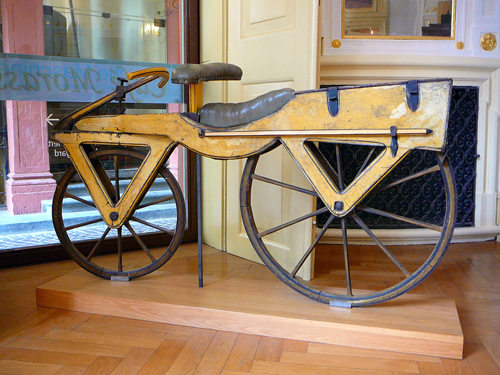
DAVID ADAMS takes a look at the weird and wonderful origins of the modern-day bicycle…
While the early origins of the bicycle remain a matter of some dispute (sketches, including some by Leonardo da Vinci, go back to at least the 16th century), this year marks 200 years since the eruption of a volcano in Indonesia spurred a German inventor to come up with what many say was the first.
The eruption of Mount Tambora in 1815 – one of the most powerful in recorded history – not only devastated lives of many in the island nation, killing thousands, it also left the northern hemisphere covered in dense smoke for months, resulting in 1816 being known as the “Year without a Summer” and leading to the failure of crops and with that, the death of millions of horses from starvation.

The Draisine, also called Laufmaschine (“running machine”), from around 1820, displayed at the Kurpfälzisches Museum in Heidelberg, Germany. PICTURE: Gun Powder Ma/Wikimedia Commons/
With horses, then the main mode of transportation, in short supply, German Baron Karl von Drais decided to work on alternative means of transportation and in 1817, in his laboratory in Mannheim, unveiled his velocipede (an all encompassing word for a human powered vehicle with one or more wheels).
Originally called the ‘Laufmaschine’ (German for ‘running machine’) and known in the press as the Draisine or drasienne in French, the design featured a saddle draped over a wooden frame upon which to the rider sat and then, their legs positioned on down either side, ran to turn the two wooden wheels (no doubt coasting when they picked up speed) while steering with a handlebar.
In 1818 in England, Denis Johnson patented his own, similar, invention, nicknamed the “hobby horse” and “dandy horse” – the latter, a derogatory comment on the men who rode them.
By the mid-1800s bicycles with pedals began to appear and in 1863, Frenchman Pierre Michaux and his son Ernest came up the idea of attaching the pedals to a cranked arm which would propel the front wheel (he presented his new design at The International Exposition in Paris in 1867). His design became known as the ‘bone-shaker’ (for rather obvious reasons!).
Other designs followed including the release of the accident-prone Penny-farthing – the bike with the giant front wheel and small back wheel – but it was in the mid 1880s that John Kemp Starley created the “Rover Safety Bicycle”, a design which resembles the bicycle as we know it today and which took its name from the fact riding it wouldn’t result in injury (as was all too common with some earlier versions).
Starley’s creation had equal sized wheels, a chain and pedal mechanism with rear wheel drive and, following their invention by John Boyd Dunlop in 1888, rubber, air-filled tyres. Other modifications followed in the coming years including the addition of the back-pedal brake and tandem seating.
Bicycles had initially been the purview of the affluent but at the beginning of the 20th century, mass production saw the price drop and the bicycle assume it’s place as a cheap, sustainable form of transport used all over the world.
Since then, the evolution of the bike has continued apace with the development of faster, lighter bikes as well as those specifically designed for more difficult terrain. We’ve come a long way from the days of Karl von Drais and his “running machine”.





